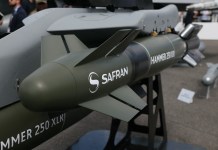As it struggles to bring home the F-35B stranded in India, the troubles of the Royal Air Force (RAF) F-35 stealth aircraft seem to be compounding.
A British public spending watchdog has flagged a host of issues with the aircraft, ranging from delays in delivery to an abysmal readiness rate, even as an F-35B remains stranded at the Thiruvananthapuram International Airport in India.
Britain’s most advanced warplane program is experiencing delays, infrastructural problems, and a lack of staff, which is compromising the country’s ability to fight wars, the National Audit Office (NAO) report published on July 11, 2025.
The UK initially committed to buying 138 F-35s, primarily the Short Take Off and Vertical Landing (STOVL) variant F-35Bs. It received 38 of these and lost one in a crash. Last month, the RAF announced that it had decided to purchase 27 more F-35s—twelve F-35A and fifteen F-35B variants.
The watchdog acknowledges that the F-35 is significantly more advanced than any prior UK aircraft, especially when it comes to electronic warfare technology, fusion of data from various sensors, and stealth.
However, it simultaneously laments the delays in deliveries.
“In 2016, the MoD announced its plan to buy 48 aircraft by the end of 2024, which it amended in February 2020 to the end of 2025. It currently has received 38 aircraft, of which one was lost in an accident in November 2021, leaving 37 currently in service. The MoD now forecasts that it will have 41 aircraft by the end of 2025 and receive its 48th aircraft at the end of April 2026. This has been caused by a combination of the MoD delaying its delivery profile to save money in the short term in response to wider financial pressures and, subsequently, problems in the global programme with the Technology Refresh 3 software upgrade,” the NAO states.
It notes that a complete delivery of the first batch of 48 fighters is currently behind schedule due to a combination of financial pressure and problems with the global program
“This means that the MoD now expects to declare Full Operating Capability at the end of 2025, two years later than planned, and with several gaps against its initial requirements.”
The watchdog further states that the plans to provide the aircraft with vital weaponry, such as missiles built in the UK, and the maintenance of the F-35 jet’s stealth capabilities have been delayed until the 2030s.
The NAO also admonished the poor “mission availability rates,” which is the ability of an aircraft to carry out at least one of its seven potential necessary missions, of the F-35 program. It revealed that the mission capability rate of the UK F-35 fleet in 2024 was almost half of the MoD’s goal, falling short of the goals of other international programs.
Notably, the NAO is not the first watchdog to flag the poor mission capability rate of the fifth-generation aircraft. Earlier, a US Government Accountability Office (GAO) report stated the F-35A’s mission-capable rate was an abysmal 51.5% in 2025, far below the 75–80% target, due to spare parts shortages and maintenance challenges.

Without listing the exact mission availability rate of the RAF’s F-35 fleet, the NAO states that the poor availability rates are driven largely by a UK shortage of F-35 engineers and a global shortage of F-35 spare parts.
“Most significantly, it had serious gaps in engineering posts in November 2024, with especially acute gaps at supervisor grades. It also had shortages of cyber professionals, pilots, and flying instructors.”
The report also stated that the MoD is far behind its planned delivery dates for integrating UK-developed missiles onto the F-35 and is pursuing interim alternatives. “The original need by date for the Spear 3 air-to-surface and Meteor air-to-air missiles was December 2024. However, the MoD now expects to have both in full service in the early 2030s.”
It added, “These delays have been caused by poor supplier performance, the MoD negotiating commercial arrangements that failed to prioritise delivery, and a low priority given to Meteor by the global programme. The MoD wants to mitigate capability risk by early delivery of a limited capability and by purchasing interim weapons.”
The NAO notes that some capabilities have been delayed to the next decade.
“Most significantly, the F-35 does not have a standoff weapon to attack ground targets from a safe range, which will impact its effectiveness in contested environments. It does not expect to have this capability in full until the early 2030s. Nor will the MoD have a sovereign facility to assure that the aircraft retain their stealth characteristics until the 2030s, much later than originally planned. Hardware and software updates, known as Block 4 and provided by the global programme, have also been delayed.”
The UK MoD earlier stated that the F-35 program will cost £18.76 billion ($25.02 billion) in total, based on the first 48 aircraft. However, considering the entire fleet of 138 aircraft that are anticipated to be in service until 2069, the NAO calculates the actual amount to be £71 billion ($94.70 billion). This covers expenses for infrastructure, training, fuel, people, and other overheads not included in the MoD’s published figures.
While the National Audit Office hailed the F-35 as “significantly superior” to any prior UK aircraft, it also added that the £11 billion already spent on the project marks a “disappointing return” when compared to the Ministry of Defense’s original goals.
Despite these drawbacks, the NAO emphasizes the economic benefits of UK’s early participation in the program. It stated that approximately 15% of all F-35 aircraft worldwide are manufactured by British companies, while they only acquire less than 5% of the fleet, adding that this has resulted in contracts worth an estimated £22 billion for UK businesses.
The report urges structural restructuring inside the MoD to solve long-standing management inefficiencies, such as short staff tenures, unclear accountability, and a lack of financial flexibility. It calls on the Department to develop a comprehensive, up-to-date, and independently verified whole-life evaluation of the F-35’s worth, which should include a more exacting capabilities measuring framework.
Interestingly, the report comes as an F-35 belonging to the RAF remains stranded at an airport in India, days after it made an emergency landing.

British F-35B Is Stranded In India
An actual F-35B belonging to the British Royal Navy made an emergency landing in India on June 14 and has been stuck there for nearly a month. The jet, part of the HMS Prince of Wales Carrier Strike Group, was on a joint maritime exercise with the Indian Navy when it diverted to the airport due to low fuel and adverse weather.
It was later discovered that the aircraft also had a hydraulic failure, which prolonged the grounding of the aircraft, as the technicians present on the scene could not repair the issue.
The $100 million was initially parked at Bay 4 under India’s Central Industrial Security Force (CISF) guard, and six RAF personnel aimed at ensuring constant UK surveillance to protect its classified technology.
After initial reluctance, the jet was moved to the hangar. After this, a 40-member UK engineering team, along with Lockheed Martin experts and specialized equipment, arrived in India earlier this month to conduct repairs in Air India’s Maintenance, Repair, and Overhaul (MRO) hangar at the airport.
#WATCH | Thiruvananthapuram, Kerala: Stranded F-35B British fighter jet being moved to the hangar from its grounded position.
A team of technical experts on board the British Royal Air Force Airbus A400M Atlas arrived at the Thiruvananthapuram International Airport to assess the… pic.twitter.com/bL9pGrJzIs
— ANI (@ANI) July 6, 2025
Some reports earlier indicated that if the repairs were unsuccessful, the jet may be dismantled (wings removed) and airlifted back to the UK via a C-17 Globemaster III.
However, more recent reports in the Indian media suggest that the aircraft is likely to be repaired and flown back to the United Kingdom as early as next week. The EurAsian Times cannot verify these claims.
The prolonged grounding has raised questions about the F-35 program’s reliability, especially given its high costs, past technical issues, some of which the EurAsian Times has discussed in detail in previous reports. The stranding of RAF F-35B does not augur well for the Lockheed aircraft
- Contact the author at sakshi.tiwari9555 (at) gmail.com
- Follow EurAsian Times on Google News




